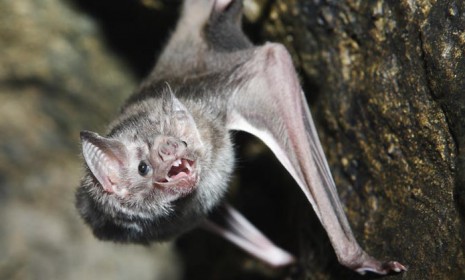New England's vampire panic
In 19th-century Rhode Island, says Abigail Tucker, farmers began digging up graves in search of vampires

CHILDREN PLAYING NEAR a hillside gravel mine found the first graves. One ran home to tell his mother, who was skeptical at first — until the boy produced a skull. Because this was Griswold, Conn., in 1990, police initially thought the burials might be the work of a local serial killer named Michael Ross, who had been sent to death row in 1987, and they taped off the area as a crime scene. But the brown, decaying bones turned out to be more than a century old.
The Connecticut state archaeologist, Nick Bellantoni, soon determined that the hillside contained a colonial-era farm cemetery. New England is full of such unmarked family plots, and the 29 burials were typical of the 1700s and early 1800s: The dead, many of them children, were laid to rest in thrifty Yankee style, in simple wood coffins, without jewelry or even much clothing, their arms resting by their sides or crossed over their chests.
Except, that is, for Burial No. 4, which was one of only two stone crypts in the cemetery. Scraping away soil with flat-edged shovels, and then brushes and bamboo picks, the archaeologist and his team worked through several feet of earth before reaching the top of the crypt. When Bellantoni lifted the first of the large, flat rocks that formed the roof, he uncovered the remains of a red-painted coffin and a pair of skeletal feet. They lay, he remembers, "in perfect anatomical position." But when he raised the next stone, Bellantoni saw that the rest of the individual "had been completely...rearranged." The skeleton had been beheaded; skull and thighbones rested atop the ribs and vertebrae. "It looked like a skull-and-crossbones motif, a Jolly Roger. I'd never seen anything like it," Bellantoni recalls.
The Week
Escape your echo chamber. Get the facts behind the news, plus analysis from multiple perspectives.

Sign up for The Week's Free Newsletters
From our morning news briefing to a weekly Good News Newsletter, get the best of The Week delivered directly to your inbox.
From our morning news briefing to a weekly Good News Newsletter, get the best of The Week delivered directly to your inbox.
Subsequent analysis showed that the beheading, along with other injuries, including rib fractures, occurred roughly five years after death.
The other skeletons in the gravel hillside were packaged for reburial, but not "J.B.," as the 50ish male skeleton from the 1830s came to be called, because of the initials spelled out in brass tacks on his coffin lid. He was shipped to the National Museum of Health and Medicine, in Washington, D.C., for further study. Meanwhile, Bellantoni started networking. He invited archaeologists and historians to tour the excavation, soliciting theories. Simple vandalism seemed unlikely, as did robbery, because of the lack of valuables at the site.
Finally, one colleague asked, "Ever heard of the Jewett City vampires?"
IN 1854, IN neighboring Jewett City, Conn., townspeople had exhumed several corpses suspected to be vampires that were rising from their graves to kill the living. A few newspaper accounts of these events survived. Had the Griswold grave been desecrated for the same reason?
A free daily email with the biggest news stories of the day – and the best features from TheWeek.com
In the course of his far-flung research, Bellantoni placed a phone call to Michael Bell, a Rhode Island folklorist who had devoted much of the previous decade to studying New England vampire exhumations. The Griswold case occurred at roughly the same time as the other incidents Bell had investigated. And the setting was right: Griswold was rural, agrarian, and bordering southern Rhode Island, where multiple exhumations had occurred. Many of the other "vampires," like J.B., had been disinterred, grotesquely tampered with, and reburied.
In light of the tales Bell told of violated corpses, even the posthumous rib fractures began to make sense. J.B.'s accusershad likely rummaged around in his chest cavity, hoping to remove, and perhaps to burn, his heart.
Almost two decades after J.B.'s grave was discovered, it remains the only intact archaeological clue to the fear that swept the region. In part because the events were relatively recent, evidence of historic "vampires" isn't as scarce as one might imagine. Incredulous city newspaper reporters dished about the "Horrible Superstition" on front pages. A traveling minister describes an exhumation in his daily log on Sept. 3, 1810. (The "mouldy Specticle," he writes, was a "Solemn Site.")
Though scholars today still struggle to explain the vampire panics, a key detail unites them: The public hysteria almost invariably occurred in the midst of savage tuberculosis outbreaks. Indeed, the medical museum's tests ultimately revealed that J.B. had suffered from tuberculosis, or a lung disease very like it. Typically, a rural family contracted the wasting illness, and — even though they often received the standard medical diagnosis — the survivors blamed early victims as "vampires" who preyed upon family members who subsequently fell sick. Often an exhumation was called for, to stop the vampire's predations.
Often these rituals were clandestine, lantern-lit affairs. But, particularly in Vermont, they could be quite public, even festive. One vampire heart was reportedly torched on the Woodstock, Vt., town green in 1830. In Manchester, hundreds of people flocked to a 1793 heart-burning ceremony at a blacksmith's forge: "Timothy Mead officiated at the altar in the sacrifice to the Demon Vampire who it was believed was still sucking the blood of the then living wife of Captain Burton," an early town history says. "It was the month of February and good sleighing."
TWO DAYS BEFORE Halloween, Michael Bell and I head through forests of swamp maple and swamp oak to Exeter, R.I., where New England's most famous vampire died. History knows the 19-year-old, late-19th-century vampire as Mercy Brown. Her family called her Lena. She lived and died in "Deserted Exeter," as it was dubbed, or simply "one of the border towns."
An early nor'easter is brewing as we pull into the parking lot of the Chestnut Hill Baptist Church, in front of Lena's cemetery. The heavy rain will soon turn to snow, and there's a bullying wind. Our umbrellas bloom inside out, like black flowers. Though it's a somber place, there's no immediate clue that an accused vampire is buried here. Unlike Salem, Exeter doesn't promote its dark claim to fame, and remains in some respects an insular community. Old-timers don't like the hooded figures who turn up this time of year, or the cars idling with the lights off. They say the legend should be left alone, perhaps with good reason: Last summer a couple of teenagers were killed on a pilgrimage to Lena's grave when they lost control of their car on Purgatory Road.
Most vampire graves stand apart, in wooded spots outside modern cemetery fences, where snow melts slower and there's a thick understory of ferns. But the Chestnut Hill Cemetery is still in use. And here is Lena. She lies beside the brother who was fed the ashes of her heart in an attempt to cure him of consumption, and the father who let it happen. Other markers are freckled with lichen, but not hers. The stone looks to have been recently cleaned. It has been stolen over the years, and now an iron strap anchors it to the earth.
HOW DID 19TH-CENTURY Yankees, remembered as the most pious and practical of peoples, come to believe in vampires — especially when the last known vampire panics at the time occurred in 18th-century Europe? Some modern scholars have linked the legend of vampires to symptoms of diseases like rabies and porphyria (a rare genetic disorder that can cause extreme sensitivity to sunlight and turn teeth reddish-brown). Exeter residents at the time claimed that the exhumations were "a tradition of the Indians."
The legend originated in Slavic Europe, where the word "vampire" first appeared in the 10th century. Bell believes that Slavic and Germanic immigrants brought vampire superstitions with them in the 1700s, perhaps when Palatine Germans colonized Pennsylvania or when Hessian mercenaries served in the Revolutionary War. "My sense is that it came more than one time through more than one source," he says.
But some modern scholars have argued that the vampire superstition made a certain degree of practical sense. In Vampires, Burial, and Death, folklorist Paul Barber dissects the logic behind vampire myths, which he believes originally arose from unschooled but astute observations of decay. (Bloated dead bodies appear as if they have recently eaten, for instance.) The seemingly bizarre vampire beliefs, Barber argues, get at the essence of contagion: the insight that illness begets illness, and death, death.
While New England's farmers may have been guided by something like reason, the spiritual climate of the day was also hospitable to vampire rumors. Contrary to their puritanical reputation, rural New Englanders in the 1800s were a fairly heathen lot. Only about 10 percent belonged to a church. Rhode Island, originally founded as a haven for religious dissenters, was particularly lax: Christian missionaries were at various points dispatched there from more godly communities. "The missionaries come back and lament that there's no Bible in the home, no churchgoing whatsoever," says Linford Fisher, a Brown University colonial historian. "You have people out there essentially in cultural isolation."
In place of organized worship, superstitions reigned: magical springs with healing powers, dead bodies that bled in the presence of their murderers. People buried shoes by fireplaces to catch the devil if he tried to come down the chimney. They nailed horseshoes above doors to ward off evil and carved daisy wheels, a kind of colonial hex sign, into door frames.
If superstition likely fanned the vampire panics, perhaps the most powerful forces at play were communal and social. By 1893, there were just 17 people per square mile in Exeter. A fifth of the farms were fully abandoned, the fields turning slowly back into forest. In her monograph The New England Vampire Belief: Image of the Decline, Gothic literature scholar Faye Ringel Hazel hints at a vampire metaphor behind the westward hemorrhage: The migration "seemed to drain rural New England of its most enterprising young citizens, leaving the old and unfit behind."
As Exeter teetered near collapse, maintaining social ties must have taken on new importance. An exhumation represented, first and foremost, a sad duty to one's own kin: The ritual "would alleviate the guilt someone might feel for not doing everything they could do to save a family, to leave no stone unturned," Bell says.
Even more significant, in small communities where disease could spread quickly, an exhumation was "an outward display that you are doing everything you can to fix the problem." Residents of the already beleaguered town were likely terrified. "They knew that if consumption wiped out the Brown family, it could take out the next family," Bell says. Lena's father, George Brown, had to make a gesture.
The strongest testament to the power of the vampire myth is that George Brown did not, in fact, believe in it. It was he who asked a doctor to perform the autopsy of his daughter at the graveyard, and he who elected to be elsewhere during the ritual. He authorized his loved ones' exhumation, The Providence Journal says, simply to "satisfy the neighbors," who were, according to another newspaper account, "worrying the life out of him."
Perhaps it was wise to let them have their way, since George Brown, apparently not prone to tuberculosis, had to coexist with his neighbors well into the next century. He died in 1922.
©2012 by Smithsonian Institution. Reprinted with permission from Smithsonian Enterprises. All rights reserved. Reproduction in any medium is strictly prohibited without permission from Smithsonian Institution. Such permission may be requested from Smithsonian Enterprises.
-
 Could a part-and-part mortgage help you on to the property ladder?
Could a part-and-part mortgage help you on to the property ladder?Combining repayment and interest-only mortgages could become more popular as part of a push towards more flexible lending
-
 Is social media over?
Is social media over?Today’s Big Question We may look back on 2025 as the moment social media jumped the shark
-
 Should parents stop tracking their kids?
Should parents stop tracking their kids?Talking Point Experts warn the line between care and control is getting murkier – and could have consequences